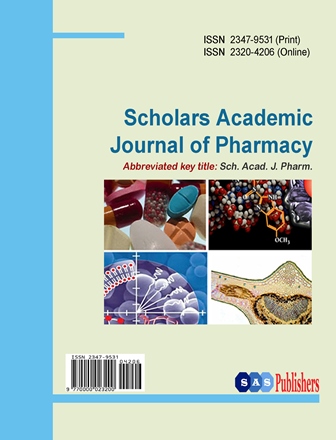+91-9365665504
+91-8724002629
submit@saspublishers.com / saspjournals@gmail.com

An International Publisher for Academic and Scientific Journals
Author Login
Scholars Academic Journal of Pharmacy
Journal Home
Description
Editorial Board
Archives
Indexing
Statistics
Title : Scholars Academic Journal of Pharmacy
Abbr : Sch Acad J Pharm
ISSN (Online) : 2320-4206
ISSN (Print) : 2347-9531
Discipline : Pharmaceutical Science
Frequency : Monthly
Country : India
Language : English
Abbr : Sch Acad J Pharm
ISSN (Online) : 2320-4206
ISSN (Print) : 2347-9531
Discipline : Pharmaceutical Science
Frequency : Monthly
Country : India
Language : English
10.36347/sajp
DOI
DOI
6.1
IMPACT FACTOR
IMPACT FACTOR
Current Issue : Volume-14 - Issue-09 ; 2025
Recently Published Articles
Nov. 29, 2025 | Original Research Article
Therapeutic Potential of Citrus limon (Rutaceae) on Induced Obesity in Wistar Rats
EKISSI Yapi Hugues Romaric, N’DOUA Akouah Richmonde Leatitia, COULIBALY Djeneba, ABO Kouakou Jean-Claude
Sch Acad J Pharm | 241-248
DOI : https://doi.org/10.36347/sajp.2025.v14i09.005
Nov. 28, 2025 | Original Research Article
Multidimensional Antidiabetic Potential of Eleusine indica Aqueous Extract: Hypoglycemic Action, Antioxidant Power, and Flavonoid Wealth
Andouormwine Abel SOMÉ, Anankpètinan Prosper DABIRÉ, Stanislas SAWADOGO, Hermann Ouoba
Sch Acad J Pharm | 235-240
DOI : https://doi.org/10.36347/sajp.2025.v14i09.004
Nov. 22, 2025 | Original Research Article
In-Vitro Equivalence Design for Nasal Spray Product Containing Corticosteroids Active Ingredient
Yağmur Akar Ceylan, Hicran Gür Dereli, Ünnügülsüm Erdoğan, Ceren Okuyucu Genç, Banu Özkırım Arslan, Enis Işık, Gönül Kayar
Sch Acad J Pharm | 208-234
DOI : https://doi.org/10.36347/sajp.2025.v14i09.003





